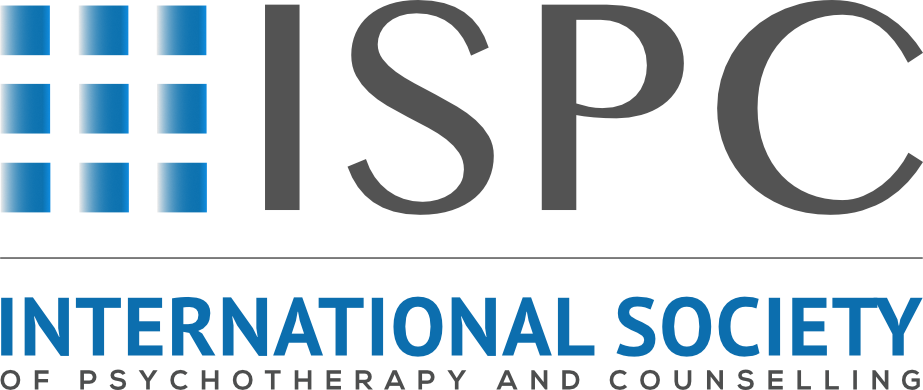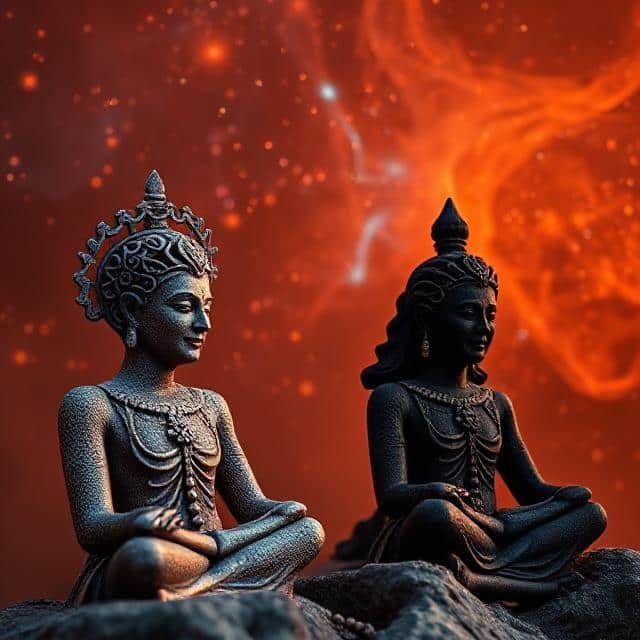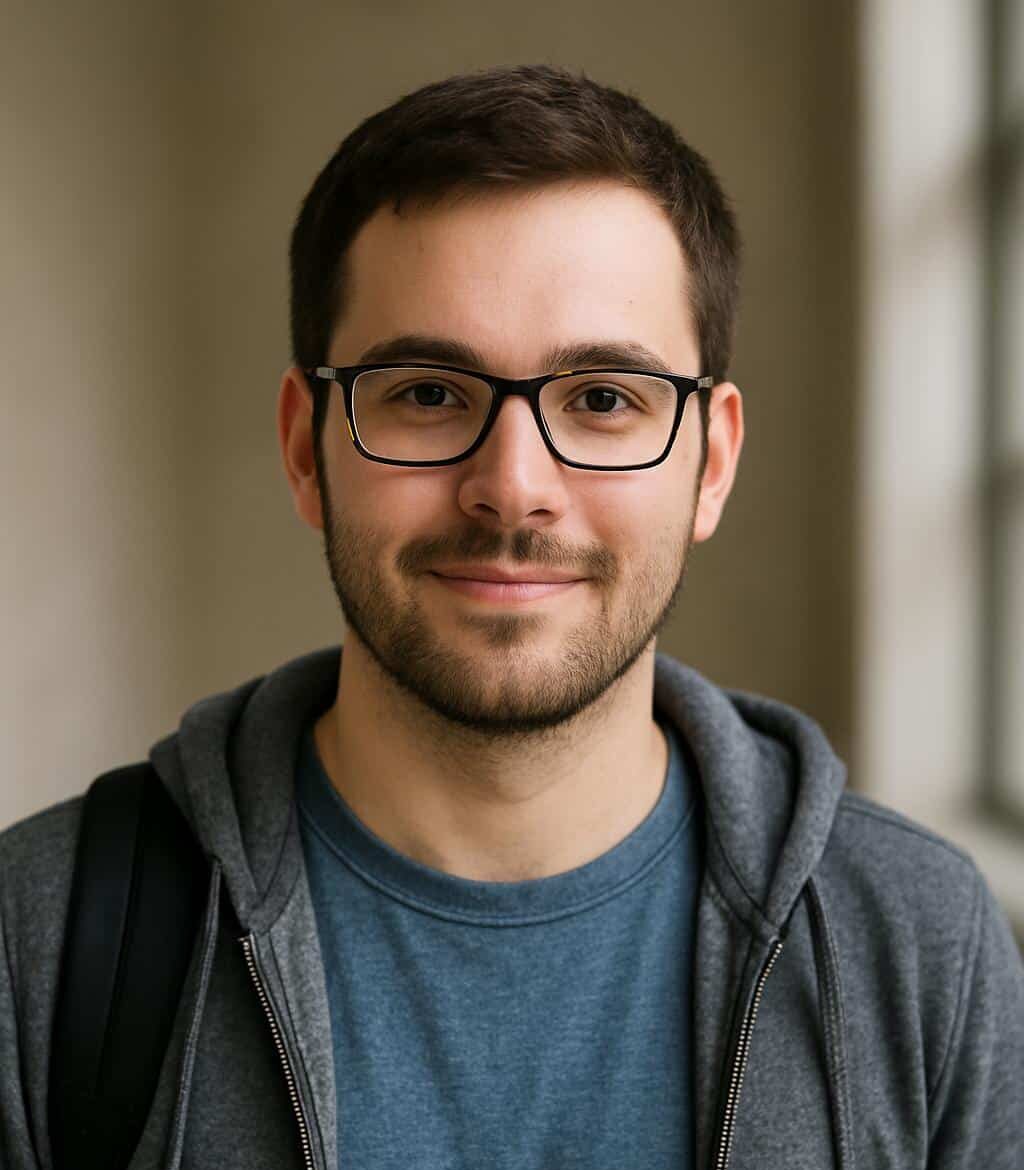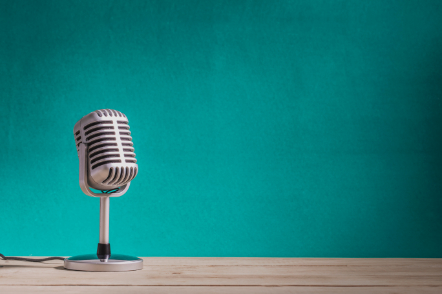An Introduction to understanding psychological therapies through the integration of quantum physics, counselling theories, and the science and philosophy of Yoga
Article authored by Turiya Martyn Gough FISPC
Around the turn of this century my schoolboy understanding of modern physics was shattered when a yoga student of mine, herself a quantum scientist, explained to me that the old Cartesian view of science was inaccurate; when a hammer strikes a nail it is not the transmission of its ‘potential and kinetic energy’ that drives the nail inwards, rather the intelligent energy field in which they both exist means that the nail ‘knows’ to move away from the hammer!
Since then, quantum science has continued to ‘uncover’ the interrelatedness of physical manifestations as well as psychic phenomena within this intelligent energy field, which has been known to the science and philosophy of yoga for more than four millennia as the manifestation of pure Consciousness.
It is my own view that without a fundamental comprehension of the human being as an intelligent energy field which creates and sustains the physical mind-body organism, all theories about psychology are founded upon the equivalent of a Cartesian approach; hence they will always miss the underlying processes.
Only by understanding that the mind-body organism does not possess a soul, rather that the soul, as the underlying field of Consciousness, is the creator of the mind-body organism, can we begin to understand our psyche’s relationship with our physical and emotional well-being.
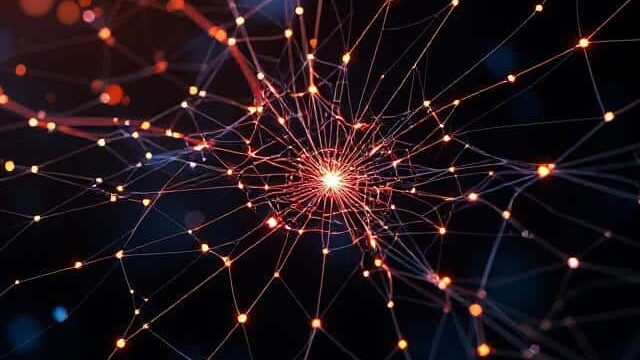
The ‘science’ of quantum psychology
Now, if the word ‘science’ catches your attention it may be because you naturally recoil from the scientific, aka reductionist, approach to therapy, or it may because you are attracted to the scientifically provable approach to therapy, as was Freud; whichever side of the divide your theoretical approach may reside I would like to introduce a perspective which bridges the divide from the transpersonal to the medical-neurobiological and offers a philosophically and scientifically integrated approach towards understanding psychological counselling.
In the beginning …
Since the late 17th century Isaac Newton’s laws have purported to demonstrate that things exist independently from each other, complete in themselves, a nail and a separate hammer, with their own inviolate boundaries. Indeed the mainstream scientific endeavor of the past three centuries has been a relentless program towards atomisation, wherein the belief has never been doubted that the secrets of the universe, of life itself, can be found by studying its individual components under an ever-more powerful microscope; the latest announcement being a 10-year, billion pound neuroscience project which aims to “revolutionise our understanding of the human brain”. [Unfortunately, it may do nothing to revolutionize our understanding of the human Being.]
Quantum physicists now confirm that the universe is not a collection of separate things jostling around in empty space but that all matter exists in a vast quantum web of connection; each living thing comprising in its most elemental state as one energy system involved in a constant transfer of information with its environment. In ancient yogic texts this phenomenon was expressed as [Sanskrit transliteration = Hari Om Tat Sat], “there is only one thing” or more accurately “everything is pure consciousness”; the core philosophy of yoga being Advaita Vedanta or ‘non-duality’, no separate nail and hammer! No separate brain, no separate person.
A holistically integrated perspective
The origins of all theoretical approaches to modern psychological therapy can be perceived, through the perspective of the science and philosophy of yoga, as just one particular strand of understanding our multi-dimensional human Being-ness. It is as if each theoretical approach sees the human Being in a two-dimensional, narrow perspective and lacks the ability to stand back and see the whole three-dimensional picture; no one model being wrong as such, but each failing to comprehend the whole context in which the human Being is manifesting; the nail knowing to move away from the hammer.
To understand the human Being holistically requires an acceptance and understanding of the vital energy system that creates and sustains life and to be able to integrate that understanding with the physical and psychological manifestations of dis-ease that are too often viewed in isolation from their creator; as if it just happened to us, we did not create it! When we examine the psychological behaviour without awareness of the emotional energy patterns, we are looking at only two of the three dimensions and consequently we are working in the dark. A parallel in counselling terms may be to suggest that Cognitive Behavioural Therapy [CBT] looks at changing the client’s patterns of behaviour without looking at the underlying causes of the behaviour; it can appear to be effective (the nail goes into the wood) but too many times the same clients turn up on my doorstep saying that the apparent ‘CBT cure’ was only temporary and they feel that underlying issues were not resolved. As long as we remain unaware of the emotional energy and how it creates, sustains and terminates life, we will always struggle to find a comprehensive theory of counselling.
Emotional energy – the life force
Many of us will have heard and read about the power of positive thinking, spontaneous remission from terminal illnesses, somatic healing, spiritual healing, placebo medication, NLP, mindfulness and meditation. All these phenomena involve an understanding of the essential life-force energy that creates and sustains the human Being, albeit that individually each of these examples sees the phenomena from its own limited perspective.
Becoming a little more specific, most people will be familiar, for example, with the Chinese practice of acupuncture wherein the human body is perceived as a network of energy channels [meridians] through which energy [chi] flows. When the energy is not flowing in a healthy fashion the physical body will develop a manifestation of ill-health or dis-ease and the acupuncturist will treat the energy flow in order to bring about good health. Some years ago, modern western medicine would have denigrated acupuncture on the basis that if a surgeon cut open a human body there would be no physical evidence of these energy channels, QED they don’t exist! More recently GPs not only recognise acupuncture but some, including my own, practice acupuncture alongside their western medicine.
Standing alongside acupuncture there are other ancient energy practices such as Tai Chi [chi being the life energy], Chi Gong, various martial arts, kinesiology, homeopathy and yoga, all of which recognise and practice control of the energy of life itself; in yoga this energy is called prāna and prānayamas are some of the many practices for releasing energy blockages [granthis], which alone has a pronounced effect on well-being. In yoga the energy channels (all 72,000) are called nādisand the energy centres through which they are distributed are known as chakras. A most rudimentary knowledge of the chakra system provides a fundamental inroad to understanding the integration of life-force energy with the physical-emotional body, because the chakras provide immediate connections between this psychic energy and physical location within the body. It is bringing conscious awareness to the relationship between this emotional energy and both physical and psychological dis-ease that is fundamental to a holistic appreciation of healing the human Being and the subject of this article.
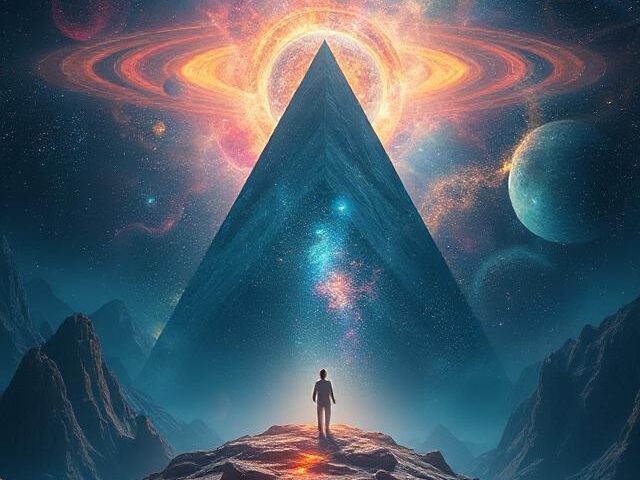
Mysticism or reality
There is nothing mystical about the body’s life-force energy that requires blind belief, it can be demonstrated and witnessed in numerous ways. I have witnessed a Tai Chi master lift a student twice his size off the ground and project him backward some 4 or 5 metres, without any physical contact, and when I asked the student how this was achieved he responded by saying that the frightening thing was that he [the Master] could do that from outside the building! The master was simply demonstrating the art of controlling his Chi.
My own karate sensei could break a house-brick, which was free-standing on its end, by a short and swift hand movement of no more than 4 cm; most of us could not do that using a club hammer!
If you sit and allow your mind and body to fall still you will discover that you can, for example, slow down your heartbeat, or access deeper levels of self-awareness; you will be controlling your life- force energy, which when unobserved will naturally revert to responding blindly to your emotions. This observation of Self [Swadhyaya] in yoga is achieved through exercising Buddhi, the discriminating part of our Being. By contrast, the egoic aspect of our Being, which over-identifies with the physical mind-body organism, is known as Manus. When control is in the hands of Manus the mind-body organism will be like a chariot under the control of five wild horses [the five external senses] but when Buddhi takes control, the chariot is steered meaningfully.
In everyday terminology an individual practiced in exercising Buddhi would, for example see jealousy arising whereas Manus would just become jealous; one could see anger arising, the other would become angry. The fundamental forces which control and determine our physical and mental health are normally outside our conscious awareness but are in fact determined by our every emotion; this network of intelligent energy is controlling everything from our heartbeat to our depression, from our backache to our happiness. As embodied beings we are this intelligent energy, but we mistakenly identify ourselves as the physical mind-body organism and not its creator; hence we struggle to understand how it is that we are reacting to stimulus and creating a new self with every experience. Taking control of our unconscious awareness is the practice of yoga and it is also the underlying process through which a client learns to understand their own process, no matter what the therapist’s theoretical model.
Advances in quantum science allow us now to understand better this field of energy in which we exist and within which we are integrally connected. This energy has now been scientifically proved to be ‘intelligent’ energy and can perhaps more usefully be understood as ‘intuitive’ energy; in essence everything you ‘feel’ will be understood and transmitted within and without your physical body [hence the power of positive thinking – and unfortunately, negative thinking; e.g. low self-esteem]. Our minds and bodies will process our underlying experiences, whether pleasurable or traumatic, and develop accordingly. I believe that what yoga defines as Consciousness is this field of intelligent energy and it has been the subject of yogic enquiry over many millennia, leading experienced yogis to a deepened awareness of the interconnectedness of life-force energy as well as physical and psychological health.
Whether one follows the medical approach of looking through the microscope to understand which neuron fires as a result of what test, or whether one leans towards a transpersonal belief in tuning into our sixth sense to gain insight, we are in either case observing the mind-body organism’s complex system of processing emotional energy.
On one occasion I was sitting with the sage Ramesh Balsakar1 in Mumbai when he mentioned that there was an understanding that the memory is not retained in a part of the physical brain, but instead is located in the Causal body, where the Causal body is understood as intelligent energy without a physical location. Ramesh also mentioned on another occasion, that although neurologists could detect the minute electrical impulses generated by parts of the brain it had taken them a while longer to notice that the ‘thought’ came first and was then followed by the electrical reaction! This was Ramesh’s way of explaining that the brain is like a computer that reacts to the information received, it does not generate the information. The information received is in the form of emotional energy which then translates as thoughts or reactions, physical and psychological. Changing the electrical pathways in the brain through medication will only appear to change the thought process, but the thoughts have already been generated; the hammer appears to drive the nail, but the nail is choosing to move away!
How does this translate into an integrated holistic therapeutic approach?
Understanding the essential nature of our energy body as an expression of Consciousness, that is fully integrated into our physical mind-body organism, allows us to more completely see and understand the client sitting opposite, and just as importantly to enable us to better understand some of the leading theorists of our era and how their work fits into this wider holistic perspective.
One of the earliest therapists working with emotional life-force energy was, of course, Carl Jung who envisaged a collective unconscious through which we are all connected, albeit we appear to be separate entities. More recently Carl Rogers2 spoke about his experiences within the therapeutic relationship in terms that are descriptive of extra-sensory interaction as opposed to clinical techniques when has said that ‘Our experiences in therapy involve the transcendent, the indescribable, the spiritual. I am compelled to believe that I, like many others, have underestimated the importance of this mystical, spiritual dimension’. More recently Alice Miller3, Peter Levine4, Babette Rothschild5and David Hawkins6, to name just a few, have also written at length on the connection between emotional energy trauma and its various physical and psychological manifestations in the body.
Some of the most recent and accurate expositions are demonstrated through the work of Peter Levine, one of the world’s leading Post traumatic Stress Disorder therapists, who has described in detail the effects of trauma on the body’s energy network with particular reference to the phenomena of what he calls frozen energy and its therapeutic release. He describes an exact interpretation of granthis, or psychic knots, known in yoga for millennia and released through various yogic practices. This is psychic/emotional/intuitive energy, being traumatised following a particular event, or series of events, and being paralysed within the body’s energy system consequently ‘holding’ the trauma unconsciously and being re-triggered by similarly stressful events. Peter has approached the subject of trauma from a thoroughly academic and research-based background and conjectured that unresolved trauma is perhaps responsible for the majority of mankind’s modern illnesses. Peter’s own research confirms the relationship between emotional experiences and physical manifestations of maladies; he mentions among others, tension in the neck evolving over time to the syndrome of fibromyalgia, migraines as a common somatic expression of unresolved stress, knots in the gut mutating into conditions like IBS, PMS and spastic colon.
He believes in the need to identify the physical sensations connected with traumatic experiences and “simply” observe them without becoming overwhelmed by them (seeing anger arise without becoming angry) ; he describes this as ‘dual consciousness’ and notes that this process is also found in ancient healing practices such as meditation, shamanism and yoga. In yoga this represents the individual’s ability to bring into conscious awareness unconscious behaviours, or automatic emotional reactions, after some years of practice at stilling the mind in order to experience that which lies beyond the mind. But essentially it is this ability to see or feel beyond the superficial experience, into the deeper experience, that brings about self-awareness. That light-bulb moment when an individual says “I have just realised ….”; that realisation which enables one to see beyond the problem to the underlying evidence; a microcosm of the yogic path to Self-realisation, really knowing the Self.
So, how does all this inform psychological therapy?
When we understand and fully appreciate the person in front of us as a Conscious Being, who is a manifestation of their own emotional energetic experiences, in both physical form and psychological consequence, we are better able to help them heal. When we understand the language of emotional energy and the implications of unconscious response to traumatic experience we are far more able to assist in the release of traumatic knots and regain healthy energetic distribution. It becomes easier to comprehend how the childhood experiences of our client formed the adult in front of us, how the smallest incident for the developing child was indeed traumatic and set in progress the energetic restrictions that are experienced by the adult. By working with our client’s ability to consciously get in touch with their unconscious self we can assist the release of traumatic causes and replace them with healthier energy stasis.
One particular area where the science and philosophy of yoga will allow the practitioner to take this further is through knowledge of the chakras [energy centres, or hubs] and it will be seen that if the original trauma was, for example sexual abuse of a young girl, the life-force energy will be paralysed around the pelvic region affecting the two lower chakras, Mooladhara and Swadhistana; consequential physical dis-ease will manifest in the same area, such as womb pain, menstrual pain, ovarian cysts, vaginal cancer, etcetera. If the trauma was around emotional neglect one can anticipate a closed heart centre, Anahata chakra, with physical symptoms being rounded shoulders, compressed chest, heart and lung problems, breast cancer, etcetera, as well as emotional problems around openness and acceptance of others, problems with unconditional love, etcetera.
Throat problems will relate to Vishudhi chakra and will manifest as say tonsillitis, teeth, tongue and gum problems, thyroid, jaw and neck issues, and will be related to communication issues often resulting from suppression by authoritarian parents who told you to be seen and not heard, or ridiculed for voicing your thoughts; Vishuddhi, the communication chakra will be closed down to some degree. All these expressions of disrupted energy flow will be demonstrated by your clients, whether obvious or subtle, and being able to identify the connection, speak the language, will greatly aid the healing process.
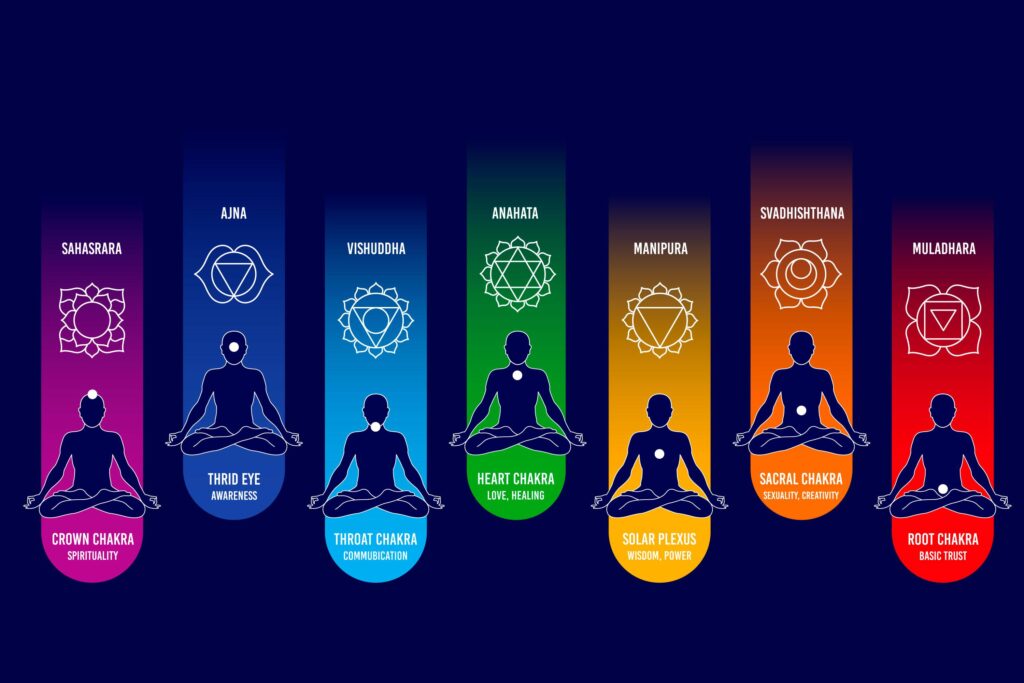
Beyond mysticism
Mysticism is terminology used to describe something that is not understood, like a foreign language, but if one is familiar with the language then what is being witnessed becomes clear, and so by learning the language of the emotional energetic body we achieve a far greater degree of clarity with our clients. The path of yoga, of which meditation is only one element, leads ultimately to the state of Self-realisation in the macrocosmic context and in the microcosmic context every client session offers an opportunity for a client to connect with their unconscious process, typified by those ‘light-bulb’ moments when he or she says “I have just realised ….!”.
Every therapist who has ever helped a client knows that it is they, the client, who does the work and it is this process of the individual connecting with their unconscious intelligence to reach their own Self-realisation that brings about the healing; contrast this with the neurobiological approach, which is direct intervention from outside, and one realises that this cannot ultimately be helpful since it deprives the individual from ever making that connection.
Conclusion
We appear to be nearing an era in which the debates over the very existence of transpersonal experiences are evolving into ‘scientifically’ verifiable evidence of the very existence of one field of energy in which all experience manifests. When the world is threatening to our clients they close down and their physical bodies reflect their dis-ease, internally and externally, but when as therapists we open our hearts to our clients they respond, like iron filings near a magnet, to align and connect with our energy field; our unconditional love offering a reparative relational energy field in which they can heal.
It’s good to talk …. it’s even better to bring unconscious behaviour into Conscious understanding and eventually into Self-awareness.
References
- Ramesh Balsakar (1917-2009 ) Sage and author of (1998)Your Head in the Tiger’s Mouth, Zen; (1982) Pointers from Nisargadatta Maharaj, Chetana
- Rogers, C. R. (1980) Way of Being. Boston: Houghton Mifflin, p 130
- Miller, A. (2006) The Body Never Lies, Norton
- Levine, P. (2010) In an Unspoken Voice, North Atlantic Books; (1997) Waking the Tiger, North Atlantic Books
- Rothschild, B. (2000) The Body Remembers, Norton
- Hawkins, D. (2002) Power vs. Force–The Hidden Determinants of Human Behaviour, Hay House
Turiya Martyn Gough FISPC is psychotherapist in private practice informed through 50 years engagement with yoga in India, China, Australia and the United Kingdom. He has received Approved Healer status from the Spiritualist National Union and teacher certification with the British Wheel of Yoga. He was given the spiritual name ‘Turiya’ by Swami Nischalananda Saraswati, the Spiritual Director of the Mandala Yoga Ashram, Inscriber of 1st Edition of ‘A Systematic Course in the Ancient Tantric Techniques of Yoga and Kriya’, Bihar School of Yoga (1981) and author of ‘The Edge of Infinity’, Manadala Yoga Ashram (2002).
Here is a link to Turiya’s Therapy Website:
https://parksidecounselling.com
We encourage all ISPC members to consider contributing to ISPC News and sharing their unique perspectives and insights. Your contributions help build a valuable resource for the therapy and counselling community.
And lastly, we appreciate those that have already come forward with their ideas and writings, we are uploading these blogs over the next few weeks and months.
Kindest Regards
ISPC Team
